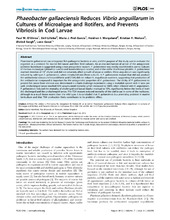| dc.contributor.author | D’Alvise, Paul W. | eng |
| dc.contributor.author | Lillebø, Siril | eng |
| dc.contributor.author | Prol-Garcia, Maria J. | eng |
| dc.contributor.author | Wergeland, Heidrun Inger | eng |
| dc.contributor.author | Nielsen, Kristian F. | eng |
| dc.contributor.author | Bergh, Øivind | eng |
| dc.contributor.author | Gram, Lone | eng |
| dc.date.accessioned | 2013-04-10T10:17:56Z | |
| dc.date.available | 2013-04-10T10:17:56Z | |
| dc.date.issued | 2012-08-22 | eng |
| dc.Published | PLoS ONE 7(8): e43996 | eng |
| dc.identifier.issn | 1932-6203 | en_US |
| dc.identifier.uri | https://hdl.handle.net/1956/6500 | |
| dc.description.abstract | Phaeobacter gallaeciensis can antagonize fish-pathogenic bacteria in vitro, and the purpose of this study was to evaluate the organism as a probiont for marine fish larvae and their feed cultures. An in vivo mechanism of action of the antagonistic probiotic bacterium is suggested using a non-antagonistic mutant. P. gallaeciensis was readily established in axenic cultures of the two microalgae Tetraselmis suecica and Nannochloropsis oculata, and of the rotifer Brachionus plicatilis. P. gallaeciensis reached densities of 107 cfu/ml and did not adversely affect growth of algae or rotifers. Vibrio anguillarum was significantly reduced by wild-type P. gallaeciensis, when introduced into these cultures. A P. gallaeciensis mutant that did not produce the antibacterial compound tropodithietic acid (TDA) did not reduce V. anguillarum numbers, suggesting that production of the antibacterial compound is important for the antagonistic properties of P. gallaeciensis. The ability of P. gallaeciensis to protect fish larvae from vibriosis was determined in a bath challenge experiment using a multidish system with 1 larva per well. Unchallenged larvae reached 40% accumulated mortality which increased to 100% when infected with V. anguillarum. P. gallaeciensis reduced the mortality of challenged cod larvae (Gadus morhua) to 10%, significantly below the levels of both the challenged and the unchallenged larvae. The TDA mutant reduced mortality of the cod larvae in some of the replicates, although to a much lesser extent than the wild type. It is concluded that P. gallaeciensis is a promising probiont in marine larviculture and that TDA production likely contributes to its probiotic effect. | en_US |
| dc.language.iso | eng | eng |
| dc.publisher | Public Library of Science | en_US |
| dc.rights | Attribution CC BY | eng |
| dc.rights.uri | http://creativecommons.org/licenses/by/2.5/ | eng |
| dc.title | Phaeobacter gallaeciensis Reduces Vibrio anguillarum in Cultures of Microalgae and Rotifers, and Prevents Vibriosis in Cod Larvae | en_US |
| dc.type | Peer reviewed | |
| dc.type | Journal article | |
| dc.description.version | publishedVersion | en_US |
| dc.rights.holder | Copyright D'Alvise, et al. | en_US |
| dc.identifier.doi | https://doi.org/10.1371/journal.pone.0043996 | |
| dc.identifier.cristin | 965148 | |

